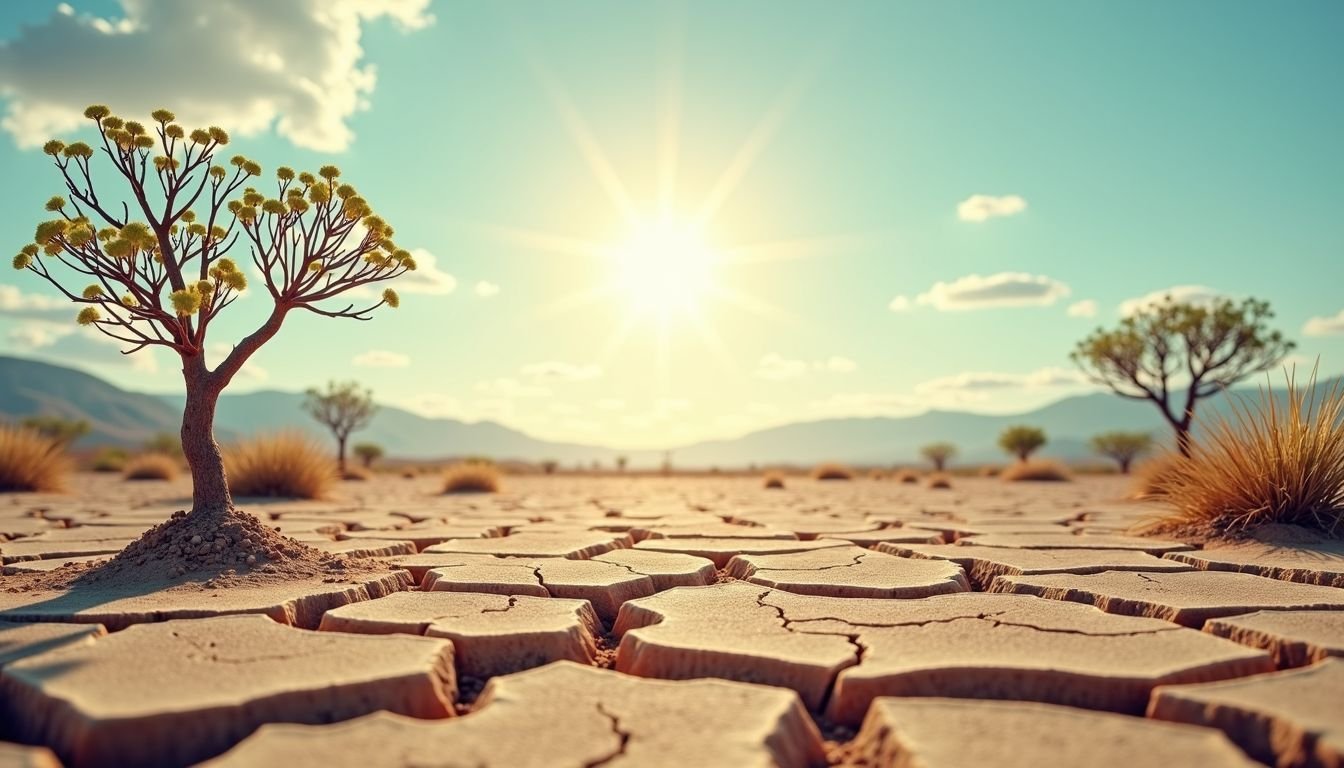Climate change is a big problem for our planet. It makes Earth hotter and causes many issues. You can help fix this problem. To reverse the climate change there are new ways which also include removing CO2 from the air.
Trees also help fight climate change. They store carbon. We can plant more trees on 2.5 billion acres of land. This would store a lot of carbon. New tools help us see how much carbon forests hold.
One tool is called Jedi. It’s on the space station!
Clean energy is key too. Wind, sun, and nuclear power are getting cheaper. Rich countries need to use only clean energy in 30 years. This will help a lot.
You can make a difference. There are many ways to help reverse climate change. From planting trees to using clean energy, every action counts. The future of our kids depends on what we do now.
Let’s act fast to save our planet!
Key Takeaways
- Earth’s temperature has risen 1.1°C since pre-industrial times, causing extreme weather, melting ice caps, and harming ecosystems.
- New tech like direct air capture can remove CO2 from the air. Some companies aim to remove 1% of air’s CO2 in 5-10 years.
- Renewable energy is now cheaper than fossil fuels in many places. Rich nations aim to use only zero-emission energy in 30 years.
- Adding 2.5 billion acres of new forests could store 205 gigatons of carbon, about 1/3 of human emissions since the Industrial Revolution.
- Everyone can help by using less energy, choosing clean power, eating more plants, and supporting climate-friendly policies and leaders.
The Impact of Earth’s Rising Temperatures

As we explore Earth’s changing climate, let’s focus on how rising temperatures affect our planet. Earth’s heat is climbing fast. This impacts everything from ice caps to forests. You see more extreme weather like floods and droughts.
Animals and plants struggle to adapt. Oceans get warmer and more acidic, harming sea life. Glaciers melt, raising sea levels and threatening coastal areas. Food and water supplies face risks.
Heat waves become more common and deadly. These changes happen faster than nature can keep up. A child born today will live on a very different Earth. The climate crisis touches all parts of life on our planet.
Promising Technologies to Mitigate Climate Change

New tech offers hope for climate change. Renewable energy leads the charge. Solar and wind power now cost less than fossil fuels in many places. This shift helps cut carbon emissions fast.
Direct air capture shows promise too. Companies like Climeworks pull CO2 straight from the air. They then store it underground or use it to make products. One cool method turns CO2 into rock in just two years.
It’s called Carbfix.
We can produce carbon-neutral liquid fuels using only sunlight and air, says researcher Aldo Steinfeld.
This tech could help planes and ships run clean. Other ideas include better batteries and smart grids. These tools will help us use clean energy more efficiently. Let’s look at how society can help reach zero emissions.
The Role of Society in Achieving Zero Emissions

You play a key role in cutting carbon emissions. Your daily choices impact the planet’s future. Switching to clean energy sources like solar and wind helps. So does using less energy at home and work.
Eating more plants and less meat cuts emissions too. You can also push for climate action in your community. Join local groups that fight for green policies. Vote for leaders who take climate change seriously.
Every small step adds up to big change.
Companies and governments must step up too. They need to invest in clean tech and green jobs. This shift can create new work and boost the economy. Cities can improve public transit and bike lanes.
Schools can teach kids about climate science. Farmers can use methods that store carbon in soil. Together, we can reach zero emissions faster. It’s a team effort that needs everyone on board.
Challenges with Existing CO2 Emissions

Society’s efforts to cut emissions are crucial, but we face a big problem with CO2 already in the air. This gas sticks around for thousands of years, even if we stop making more today.
It’s like a stubborn stain that won’t wash out. The CO2 we’ve put out keeps heating up Earth, making our job harder.
Dealing with old CO2 is tough. We need new tools to clean it up. Some ideas include planting more trees or using machines to suck CO2 from the air. But these methods are still new and small-scale.
We must work fast to find better ways to remove CO2 and cool Earth down. Every day counts in this race against rising temps.
The New Toolkit for Climate Challenges

Scientists are creating new tools to fight climate change. These tools go beyond just cutting emissions. They aim to remove CO2 from the air and cool the Earth.
One key tool is direct air capture. This tech pulls CO2 straight from the atmosphere. Companies like Climeworks are leading the way. They’ve built machines that can suck up tons of CO2 each year.
Another tool is solar geoengineering. It involves reflecting sunlight back into space. This could help cool the planet fast.
Renewables are also part of this new toolkit. Solar and wind power are now cheaper than ever. They offer a path to zero-emission energy systems. Data-driven solutions are emerging too.
These use AI to track forests and measure carbon storage. All these tools work together to tackle the climate crisis head-on.
Humanity’s Role as Stewards of the Planet

As we explore new tools to fight climate change, we must also consider our role as Earth’s caretakers. You have a vital part to play in protecting our planet. Your daily choices impact CO2 levels and global temperatures.
Simple actions like using less energy or choosing eco-friendly products make a difference.
Developed nations need to lead the charge in cutting emissions. You can push for clean energy policies and support companies that prioritize sustainability. Plant trees, reduce waste, and opt for public transit when possible.
These steps help slow the warming trend. By acting as responsible stewards, you safeguard Earth for future generations. Your efforts, combined with others, can create real change in the fight against climate change.
The Future of Children in a Warming World

As stewards of the planet, we must consider the future of our children. Kids born today will face a very different world. Rising temperatures will change their lives in big ways. They’ll see more extreme weather, like floods and droughts.
Food and water might become harder to get in some places.
You can help make a better future for kids. Cut your carbon footprint by using less energy at home. Choose clean power sources like solar or wind. Teach children about nature and how to protect it.
Support policies that fight climate change. Every action counts to cool down our planet for the next generation.
The Necessity of Rapid Emissions Cuts

Rapid emissions cuts are crucial now. Climate impacts worsen faster than expected. We must act fast to avoid irreversible damage. Developed nations need to switch to zero-emission energy in just 30 years.
This shift is vital to slow global warming.
You can help by making changes in your daily life. Use less energy at home. Choose public transport or electric cars. Eat more plant-based foods. These small steps add up. They reduce your carbon footprint.
Every action counts in this fight against climate change.
Businesses and governments play a big role too. They must invest in clean energy like solar and wind power. Old, polluting industries need to change or close. New laws can push for greener practices.
Together, we can cut emissions and protect our planet’s future.
The Rise of Renewable Energy Sources

Renewable energy is taking over. Wind, solar, and nuclear power now cost less than fossil fuels in many places. This shift helps fight climate change. You can see more solar panels on roofs and wind farms popping up.
These clean energy sources don’t release harmful gases into the air.
Countries are racing to switch to renewables. Rich nations aim to use only zero-emission energy in 30 years. This goal means building lots of new wind turbines and solar farms. It also means improving ways to store energy for when the sun doesn’t shine or wind doesn’t blow.
You’ll likely see more electric cars and buses in your town soon too.
Innovations in CO2 Removal and Conversion
New tech tackles CO2 head-on. Climeworks, a Swiss startup, aims to remove 1% of air’s CO2 in 5-10 years. They capture CO2 and store it underground. XPRIZE offers $20 million to turn CO2 into useful stuff.
Carbon Upcycling Technologies makes solid nanomaterials from carbon emissions. These ideas fight the 37 gigatons of CO2 we release yearly. Picture that as coal filling the National Mall – it’s a lot!
Companies race to cool Earth down. Direct air capture pulls CO2 right out of the sky. Some tech turns this gas into products we can use. Others lock it away deep in the ground. These methods could help stop global warming.
They work alongside clean energy and forests to cut greenhouse gases. Every year, we burn 10 gigatons of carbon. New tools like these are key to fixing our climate mess.
Direct Air Capture and Solar Geoengineering
Direct air capture and solar geoengineering offer hope in the fight against climate change. These new tools aim to remove CO2 from the air and cool the Earth. Climeworks, a Swiss company, has built a plant that pulls CO2 straight from the atmosphere.
Their goal is to remove 400 million tons of CO2 in the next 5-10 years. This amount equals one percent of all CO2 in the air. The captured CO2 can then be stored underground, keeping it out of our skies.
Solar geoengineering takes a different approach. It tries to reflect sunlight back into space to cool the planet. One method sprays tiny particles high in the sky to block some sun rays.
Another idea is to make clouds brighter so they reflect more light. These methods could help lower Earth’s temperature fast. But they also carry risks and need more study. Both direct air capture and solar geoengineering are part of a growing toolkit to tackle climate challenges.
They join other efforts like cutting emissions and planting trees in the race to cool our planet.
Supplementary Insights from the Documentary
The documentary offers eye-opening facts about climate change. It shows CO2 emissions in a new light. You’ll learn about clever ways to remove and store carbon. Plus, you’ll discover how trees and soil can help cool our planet.
Read on to explore these exciting ideas!
CO2 Emission Visuals and Their Impact
CO2 emissions pose a huge threat to our planet. Visual aids help us grasp the scale of this problem.
- National Mall coal visual: Picture the entire National Mall in Washington, D.C. filled with coal. This amount equals just one day’s worth of global CO2 emissions.
- Annual carbon burning: We burn 10 gigatons of carbon each year. This creates a staggering 37 gigatons of CO2 released into the air.
- Long-lasting effects: CO2 stays in our air for thousands of years. This means we must remove it, not just cut emissions.
- Underground storage goal: Scientists aim to store 400 million tons of CO2 underground. This equals about 1% of CO2 in the air.
- Solar fuel creation: New tech can make fuel from sunlight and air. This process captures CO2 and turns it into useful products.
- Rock storage method: Carbfix turns CO2 into solid rock in under two years. This offers a way to lock away carbon long-term.
Analogies to Apollo 13 Mission for CO2 Removal
Moving from CO2 emission visuals, we can draw a parallel to a famous space mission. The Apollo 13 mission offers a unique comparison to our current climate challenge.
In space, astronauts faced a life-threatening CO2 buildup. They had to create a filter fast. This mirrors our need to remove excess CO2 from Earth’s air. The mission’s quick fix inspires today’s climate solutions.
Scientists now work on ways to capture CO2 from the air, just like the Apollo 13 crew did in their spacecraft.
Companies like Climeworks are leading this charge. They’ve built plants that pull CO2 straight from the sky. This tech mimics the Apollo 13 filter on a much larger scale. It’s a key tool in our fight against rising temperatures.
These efforts show how human ingenuity can tackle big problems, both in space and on Earth.
Potential of Storing CO2 Underground
CO2 storage underground offers a promising solution to climate change. Iceland’s basalt rocks naturally bond with CO2, making it ideal for carbon capture. Sandra Schneiber’s team developed Carbfix, a method that turns CO2 into solid rock in less than two years.
This process permanently stores the greenhouse gas.
The Carbfix method dissolves CO2 in water and injects it into basalt. There, it reacts to form solid minerals like calcium carbonate. This technique could help tackle the 37 gigaton annual emissions from the global cement industry.
The goal is to cut cement use by up to 25%. Direct air capture tech also shows potential, extracting CO2 straight from the air. However, it faces scale and cost challenges.
Cutting-edge Companies like Climeworks and Carbfix
Climeworks and Carbfix lead the charge in CO2 removal. Climeworks aims to remove 400 million tons of CO2 from the air in 5-10 years. They use waste heat to power their capture process.
Carbfix turns CO2 into solid rock in under two years. They inject CO2-water mix into basalt rock, where it forms minerals. This method could cut a power plant’s emissions by one-third.
These firms show promise in fighting climate change. Their work opens doors for new ways to cut greenhouse gases. Next, we’ll look at how trees play a role in carbon capture.
The Potential of Trees in Carbon Capture
Trees pack a powerful punch in the fight against climate change. A football field-sized area of forest can store about 150 tons of carbon. That’s huge! Scientists say we could add 2.5 billion acres of new forests worldwide.
This extra tree cover could soak up 205 gigatons of carbon. That’s nearly a third of all the carbon humans have released since the Industrial Revolution.
New tech helps us understand trees better. Lola Fatoyinbo uses laser scanners to measure how much carbon trees hold. Another tool, called Jedi, zaps lasers from space to map forests in 3D.
Tom Crowther’s lab uses these gadgets to plan where to plant more trees. They want to maximize carbon capture across the globe. With three trillion trees already on Earth, there’s room for many more.
Planting trees is a simple but mighty way to cool our planet.
Advanced Technologies for Measuring Forest Carbon
Trees play a vital role in carbon capture. Now, cutting-edge tech takes this knowledge further. Terrestrial laser scanners shoot billions of laser pulses to measure forest carbon. These scanners create 3D maps of forests, showing carbon storage in detail.
Space tech joins the fight too. Jedi, a new tool on the International Space Station, uses lasers to measure forest carbon globally. It reveals that a football field-sized area can hold about 150 tons of carbon.
This data helps scientists plan better. They now know Earth has three trillion trees, way more than once thought. With this info, experts like Tom Crowther work to expand forests for max carbon capture.
Their goal? To add 205 gigatons of stored carbon by restoring 2.5 billion acres of forest.
Expanding Global Forests for Carbon Storage
Advanced tech helps us measure forest carbon better. Now, let’s look at how we can grow more forests worldwide.
Earth has about three trillion trees. That’s way more than we thought before. But we can add even more. There’s room for a trillion new trees on 2.5 billion acres of land. That’s as big as the United States! These new forests could store 205 gigatons of carbon.
This would help fight the 660 gigatons of carbon humans have put out since factories started. Some people worry if we can count tree carbon right. That’s why Lola Fatoyinbo wants to use NASA tech to get better numbers.
More trees mean less carbon in the air. It’s a simple but powerful way to cool our planet.
Grasslands and Soil Health as Carbon Solutions
Forests aren’t the only natural carbon sinks. Grasslands also play a big role in storing carbon. These vast areas of land cover about 40% of Earth’s surface. They hold huge potential for fighting climate change.
Grasslands trap carbon in their roots and soil. This process is called carbon sequestration. Scientists are now studying how to boost this natural ability. One key method is composting.
It turns waste into rich food for plants. Compost helps soil store more carbon over time. It also makes plants grow better. This creates a cycle of more carbon storage.
Farmers can use these methods on a large scale. They can add compost to their fields. This improves soil health and stores more carbon. It’s a win-win solution. The land becomes more productive.
At the same time, it helps fight climate change. These simple steps could have a big impact on our planet’s future.
The Urgency of Diverse Climate Solutions
Climate change demands swift action. We need many solutions working together. Better transport, clean energy, and smarter farming all play a part. Direct air capture tech can pull CO2 from the sky.
Trees and soil store carbon too. Each method helps, but none can fix the problem alone. We must use all tools available to cool Earth down.
Human ingenuity drives new ideas to fight global warming. Scientists create ways to remove greenhouse gases. Engineers design efficient electric vehicles. Farmers adopt practices that keep carbon in the soil.
Your choices matter too. You can eat less meat, save energy at home, and support green policies. The next section explores how human creativity tackles climate challenges.
The Role of Human Ingenuity in Combating Climate Change
Diverse solutions are vital, but human ingenuity drives them all. You play a key role in this fight. Your ideas and actions can spark big changes. People like you create new ways to cut emissions and remove CO2.
You might dream up better solar panels or invent machines to clean the air. Your smart choices in daily life add up too.
Human creativity tackles climate issues from many angles. You can help design greener cities or find ways to store carbon in soil. Your work on electric cars or wind farms makes a difference.
Even small inventions, like more efficient light bulbs, matter. Together, we have the brainpower to solve this global problem. Your unique skills and thoughts are part of the solution.
Conclusion
Climate change demands swift action. You can make a difference today. Start by reducing your carbon footprint. Switch to renewable energy sources like solar or wind. Plant trees to absorb CO2 from the air.
Support companies that use direct air capture tech. Your choices matter – be part of the solution.
FAQs
1. What’s the big deal about climate change?
Climate change is heating up our planet… fast. It’s messing with ocean currents, causing air pollution, and hurting biodiversity. We need to act now to stop these impacts.
2. How can we cool down Earth?
We can cool Earth by cutting carbon dioxide emissions. Use more wind energy and solar power. Plant trees to fight deforestation. Switch to energy-efficient appliances. These steps help reverse the greenhouse effect.
3. What’s the Paris Agreement all about?
The Paris Climate Agreement is a global plan to control climate change. It aims to keep Earth’s temp rise below 2°C. Countries work together on sustainable development and cutting greenhouse gas emissions.
4. Can changing what we eat help?
Yes! A plant-rich diet lower on the food chain can make a big difference. It cuts down on cattle farming, which produces lots of methane. Also, reducing food waste helps a ton.
5. How do renewable energy sources help?
Renewable energy like wind, solar, and geothermal power generate electricity without burning fossil fuels. They’re clean sources of energy that don’t add to carbon dioxide emissions. Using more rooftop solar panels can really help.
6. What can I do at home to help reverse climate change?
Use heat pumps instead of gas heaters. Try recycling more. Install energy-efficient lights. Consider going all-electric with your appliances. These small changes add up to make a big impact on controlling global warming.







